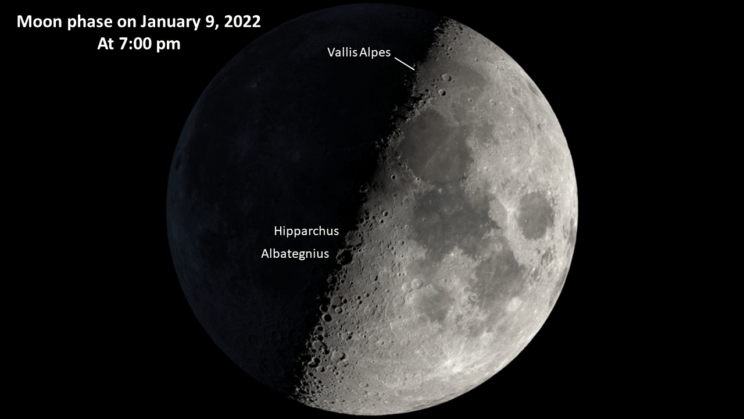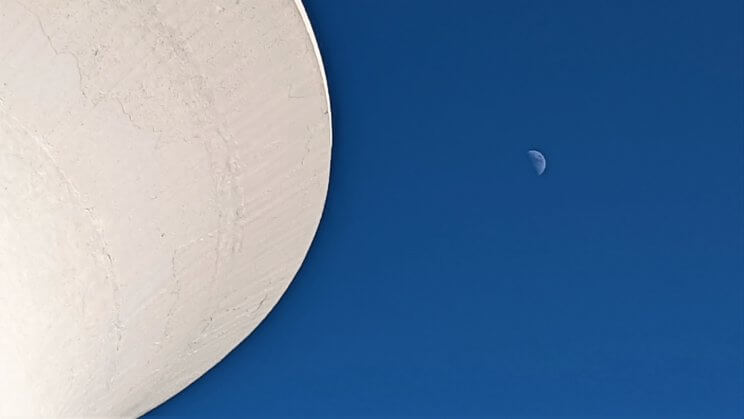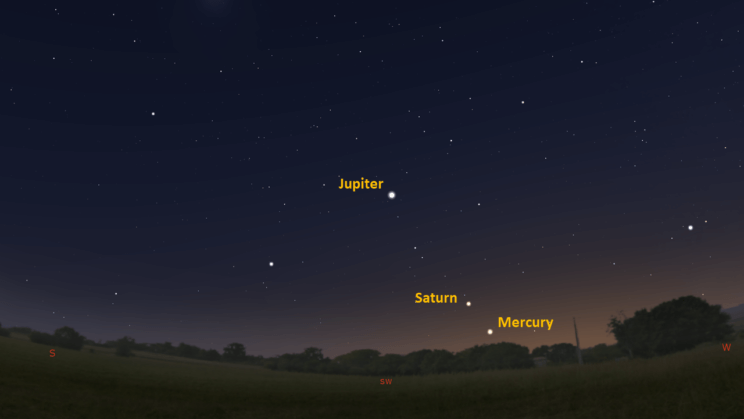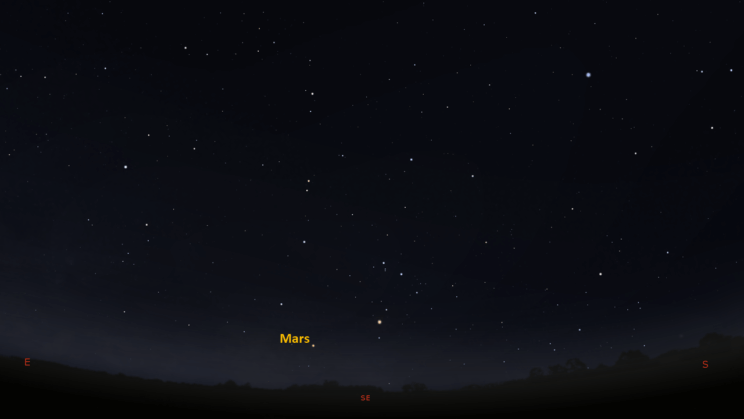This is the Saint Louis Science Center’s NIGHT SKY UPDATE for the week of Friday, January 7, 2022.
Information updated weekly or as needed.
Times given as local St. Louis time which is Central Standard Time (CST). For definitions of terminology used in the night sky update, click the highlighted text. If relying on times posted in Universal Time (UT), St. louis is -6 hours when CST.
Public Telescope Viewings
With the changing recommendations from the CDC regarding COVID-19, conversations regarding the return of star parties at the Saint Louis Science Center have begun. We are close to bringing back our public telescope viewings, but a few details still need to be worked out. We will post future updates as we learn more about when we can bring back telescope viewings.
Observing Highlight of the Week

Phase of the Moon seen on January 9, 2022 when the Moon is just past first quarter phase. Image credit: NASA, SVS, Ernie Wright.
The Moon will reach first quarter phase on January 9, 2022, at 12:11 p.m. First quarter phase is a good time for many to learn about lunar observing because it is found high in the south as the evening starts when most are likely to be out observing.
When learning about the Moon, a good place to start is with moon phases. The Moon completes a cycle of phases every 29.5 days. This is called a synodic month with which humanity once used to keep time. If you have ever wondered why each month’s full moon has a special name, it stems from when moon phases were used to track time. Full moons were often named for something connected to that month. In January, the full moon is often called the Full Wolf Moon and in February it is often called the Full Snow Moon. This is not to be confused with the term Blue Moon which relates to the number of full moons in a month or season.
A synodic month starts with new moon. As the Moon orbits Earth, it goes through its waxing phases; crescent, first quarter and then gibbous. The Moon reaches its full phase when it is at opposition after which it then cycles through its waning phases from gibbous to last quarter to crescent and back to new moon. Each cycle is called a lunation of which January 2022 is lunation 1225. For most viewers, the waxing half of the cycle is easier to observe as the Moon will be visible in the early evening. After full moon the Moon rises later each night becoming an early morning target.
The Moon is also an excellent daytime target. Daytime views of the Moon are best around the quarter phases. If it is near first quarter, the Moon is easy to find in late afternoon. If it is near last quarter, the Moon is best seen in the morning after sunrise. Most phases of the Moon are visible in daytime except for new and full moon. New moon occurs when the Moon is between Earth and the Sun and as such the side of the Moon facing the Earth is not reflecting sunlight. Full moon occurs when the Moon is seen opposite the Sun. Because of this opposition, the day full moon occurs is when the Moon rises as the Sun sets. Also keep in mind if you are trying to spot the Moon a few days after or before new moon, there is some danger involved. When close to new moon, the Moon and Sun will appear very close together and as such precautions should be taken to ensure you do not accidentally look at the Sun.
Day or night, the Moon is the most detailed object visible to us thanks to it being the nearest object to the Earth. Surface features are visible without optical aid. Naked eye views are limited but the Moon offers details to all methods of observing. The lunar surface is covered with impact craters, impact basins, and ancient lava flows. Smaller scale features such as lava domes, rilles, grabens, escarpments and many other earthlike surface features can be found through binoculars and telescopes. Lunar swirls, light flashes and other light effects are more challenging targets for those looking for something beyond the usual targets. The Moon has so much to look at, there are some who spend most of their time observing just the Moon.
The best place to look when observing the Moon is along the terminator. This is the line that separates night and day on the Moon. The terminator’s location is always changing as the Moon orbits Earth. Because of deep shadows cast along the terminator owing to the low angle of sunlight, we see the best contrast of the lunar surface. On the evening of January 9, 2022, a few prominent features can be found on the terminator. Those with binoculars can look for the two large impact craters, Hipparchus and Albategnius. Both will be easy to spot as they straddle the terminator and appear in the middle of the Moon. These will be interesting craters to watch over the next few nights as the shadow play caused by the changing angle of sunlight will cause the craters to look a little different each night.
Another interesting feature to look for is called the Alpine Valley. Officially called Vallis Alpes. This feature is likely a graben. It is likely that a large block of lunar crust dropped down along fault lines. The valley floor is flooded with mare basalt from Mare Imbrium and Frigoris. Vallis Alpes is in the Alpes Mountains on the Moon which are part of the eastern edge of the Imbrium basin. From the northern end of the terminator, you will find about a fourth of the way down a gash like feature extending out of the eastern side of the mountains. On January 9 it will still be mostly in shadow but each day after will reveal more of the valley.
The Moon is a fascinating object to study for a multitude of reasons. Something to look forward two are the two total lunar eclipse this year. The first is on May 15/16, 2022, and the second is on November 8, 2022. For more on observing the Moon, I would recommend visiting the Sky and Telescope website. They have gathered several of their past articles on lunar observing. Each is worth reading as they have lots to teach. One I recommend explores shadows on the Moon. You can find that article here.

Daytime view of first quarter moon seen next to James S. McDonnell Planetarium on January 9, 2022. Image credit: Eric Gustafson.
The Sun and Moon

The Moon as seen from the International Space Station, on July 31, 2011.
Credit: NASA
Sunrise is at 7:19 a.m. on Friday, January 7 and sunset is at 4:56 p.m. providing us with a little over 9.5 hours of daylight. Even after sunset, the light from the Sun will dimly illuminate our sky for roughly 1 hour and 30 minutes. This period is called twilight, which ends around 6:31 p.m. this week. For those with a sundial, local noon occurs around 12:07 a.m. this week.
| Day | Sunrise | Sunset |
|---|---|---|
| 2022-01-07 | 7:19 a.m. | 4:56 p.m. |
| 2022-01-08 | 7:19 a.m. | 4:57 p.m. |
| 2022-01-09 | 7:19 a.m. | 4:58 p.m. |
| 2022-01-10 | 7:18 a.m. | 4:59 p.m. |
| 2022-01-11 | 7:18 a.m. | 5:00 p.m. |
| 2022-01-12 | 7:18 a.m. | 5:01 p.m. |
| 2022-01-13 | 7:18 a.m. | 5:02 p.m. |
| 2022-01-14 | 7:17 a.m. | 5:03 p.m. |
| 2022-01-15 | 7:17 a.m. | 5:04 p.m. |
Moon
Moonrise for Friday, January 7 occurs at 10:58 a.m. and moonset will occur at 10:42 p.m. On Friday, January 7 the Moon will exhibit a waxing crescent phase with 33% of the lunar disk illuminated. First quarter moon occurs on January 9, 2022, at 12:11 p.m.
International Space Station (ISS) Observing

Visible passes of ISS from St. Louis for the week of January 7 occur during morning hours and transition to evening hours by the end of the week. The best passes this week occur the morning of January 10 and the evening of January 16. Use the table below for information about these and other visible passes this week.
Catch ISS from St. Louis starting Friday, January 7
| Date | Starts | Max. altitude | Ends | |||||||
|---|---|---|---|---|---|---|---|---|---|---|
| Time | Alt. | Az. | Time | Alt. | Az. | Time | Alt. | Az. | ||
| 09 Jan | -0.7 | 04:45:18 | 16 | ESE | 04:45:18 | 16 | ESE | 04:46:03 | 10 | ESE |
| 09 Jan | -1.6 | 06:18:14 | 12 | WSW | 06:19:07 | 13 | SW | 06:20:46 | 10 | SSW |
| 10 Jan | -1.7 | 05:32:21 | 18 | SSW | 05:32:21 | 18 | SSW | 05:33:45 | 10 | S |
| 16 Jan | -3 | 18:56:20 | 10 | SW | 18:58:49 | 46 | SSW | 18:58:49 | 46 | SSW |
Magnitude (Mag): The Measure of brightness for a celestial object. The lower the value is, the brighter the object will be.
Altitude (Alt): The angle of a celestial object measured upwards from the observer’s horizon.
Azimuth (Az): The direction of a celestial object, measured clockwise from an observer’s location with north being 0°, east being 90°, south being 180° and west being 270°.
For information about ISS flyovers and other visible satellites, visit www.heavens-above.com
Detailed information regarding all unmanned exploration of our universe, missions past, present, and planned, can be found at Jet Propulsion Laboratories:
The Visible Planets

Looking southwest, at 5:50 p.m. January 8, 2022. Credit: Stellarium, EG

Looking southeast, at 6:00 am, January 9, 2022. Credit: Stellarium, EG
This week, five naked eye planets are visible. Mercury, Jupiter and Saturn are visible in the southwest after sunset. Mars is still tough to see but it is steadily climbing out of the Sun’s glare in the east before sunrise.
Mercury
Mercury is exhibiting an evening apparition. Those with clear horizons to the southwest will see Mercury about 30 minutes after sunset. Mercury reached greatest eastern elongation on January 7, 2021. This means the elusive planet will be seen closer to the Sun each day so get your views in this week. Mercury reaches inferior conjunction on January 23, 2022.
Mars
A new apparition for Mars has begun. Mars rises at 5:18 a.m. Start looking for Mars around 6:00 a.m. as it clears trees and buildings. Mars will continue to climb out of the Sun’s glare as we see the end of 2021. Mars reaches opposition next year on December 7, 2022.
Jupiter
Look for Jupiter in the southwest as it starts to darken outside. Jupiter sets at 8:28 p.m. and will set about 30 minutes earlier each week. Jupiter reaches superior conjunction on March 5, 2022.
Saturn
Saturn is visible about 20 minutes after sunset in the southwest. Saturn sets at 6:51 p.m. Saturn will reach superior conjunction on February 4, 2022.
James S. McDonnell Planetarium
Night Sky Update: January 7 – January 15, 2022






